written by Jan Eastman | Chair PRHRiA
After a very busy rosey October, Perth Heritage Roses took an overnight bus trip on November 9 and 10 to the South of Western Australia to visit beautiful rose gardens that were in full bloom at this time of the year. We thoroughly enjoyed being surrounded by glorious roses and delightful companionship.
Mostly Roses, Newlands
Our first stop was at Newlands to visit Mostly Roses which is the most amazing place featuring many huge banks of roses many metres high. Seamus Johnson is the owner and continues to plant more roses and build more arbours and arches that feature in the garden, many with roses drooping over and around them. Seamus has a large variety of roses with modern to beautiful old heritage roses.

It is a huge area and when travelling down the South West Highway you come around a bend in the road and there on the left you see banks of roses along the fence line, and then you look across the fields to the masses of roses in the garden. It is a garden I never grow tired of viewing.
Some of the very large roses are Wedding Day, Rose Marsh seedling, Multiflora, American Pillar, Albertine, New Dawn and any more. Some of the old huge bush roses feature Tea Roses, Hybrid Musks, Damask, Rugosa and many that you just don’t see in any other garden. Seamus also has a large range of modern roses and smaller varieties, all looking amazing. It is truly a magnificent collection of roses.
We then went onto Bridgetown for lunch and to visit a quaint Nursery featuring companion plants that you don’t see in a lot of nurseries, plus roses and all sorts of plants. What really made this nursery special were the little Blue Wrens that flittered amongst the garden and us.
Glen Warren, Quinninup
Our last garden for the first day was a member’s garden at Quinninup, so back in the bus and off we went. This is set in a green valley with sheep and kangaroos grazing on the grass. Pauline met us and gave us a short talk on the history of the property, ‘Glen Warren’, then served us afternoon tea from the verandah of the home with scones, jam and cream, date loaf and a Lemon Biscotti whilst we either sat or walked in the peace of this wonderful old historic place. Afterwards we took a gentle walk around the old buildings and gardens of this beautiful historic property with Pauline explaining about the roses and the various old buildings. It was the perfect way to end our day before driving to Pemberton for dinner and overnight stay.

This is the history of ‘Glen Warren’ by Pauline.
“My grandfather was teaching at Group Settlement Number 10 (Glenoran) in 1924 when he heard about a property on the Warren River and persuaded his parents, my great-grandparents to take it up.
The property of nearly 1200 acres was mainly bush and had originally been selected by Captain Charles Barnes and his brother, both of whom were killed in the First World War. The Arnold family with two sons were the next owners and built a good timber house and large barn, but found the life too isolated.
As the property came under the Soldier Settlement Scheme, my grandfather - a returned serviceman - applied for and was granted ownership for 1,825 pounds. So in 1925, my great-grandparents (the Rooneys) and many of their 11 children came to live at the place they now called Glen Warren and commenced clearing large areas of huge trees, growing potatoes and raising dairy cattle.
Of the 11 children, several of the older ones were teachers who contributed income as well as labour in their holidays, while the youngest was just 10 years old when they arrived. A few of the children married and settled on the farm at various times, hence the numerous extra buildings. Over the years, all of them worked hard in various ways to develop the farm and it was the hub for the expanding family. As a child, I spent most of my May and August school holidays there with my grandparents, along with numerous other cousins.
My great-aunt, Sheila Gravett, was the last resident on Glen Warren when it was sold in 2003. She was 95 and lived the next 6 years on her daughter’s farm in Boddington.
After 78 years in the family, the property was sold to a developer who subdivided it into 9 separate allotments. All but the home block were sold off, until 10 years later when one of my cousins saw it advertised while browsing the internet. So in 2013, Mark and I took a trip to check it out, just for a sticky beak. On a whim, we made an offer, and lo and behold, here we are, bumbling along with a place very dear to my heart.
What we discovered was a number of buildings in various states of decay and the remnants of what had been a beautiful garden tended by Auntie Sheila and others, albeit now rather overgrown with weeds. Kangaroos definitely considered it their territory and fences were very poor at keeping them out.
I knew that members of HRIA had visited in 1999 and mapped all of the 97 roses in the garden, so I made contact with Patricia Routley who supplied me with the map, the names of the roses and lots of correspondence about them. That was a treasure trove. Only 35 of the roses remained, so I weeded and nurtured them and waited for them to bloom so they could be identified. There are only a couple which remain unknown today, mainly because I haven’t seen them flower or they don’t seem to match the map.
The roses of oldest provenance came from Capel where the family lived between 1905 and 1914. They are a white moss rose, maybe Quatre Saisons Blanc Mousseaux, and the rose known to Sheila as the cabbage rose, possibly John Hopper. Another rose of interest is the deep red hybrid perpetual Dr Hogg, the cutting of which came from the Wringe family in Kirup. It appears to be quite a rare rose, though I have managed to strike a few cuttings and give them to family members as well as John Wringe who now lives in Donnybrook.
Our purchase of Glen Warren prompted me to join HRIA and I’ve been fortunate to meet many helpful and knowledgeable new friends. As we can, we are hoping to bring back some of the roses that once graced the garden and add a few more beauties that I’ve learned about through these connections. Hawlmark Crimson has come back already, thanks to Di Durston. Lady Hillingdon was Sheila’s favourite and I’m hoping to source that one too.”
Rose Haven, Kirup
The second day we were up and onto the bus to head back towards Perth stopping at Kirup at a property called ‘Rose Haven’, owned by Chris and Leigh Wilson, which covers an area of 5 acres that includes a large lake.

On arrival we were welcomed with morning tea where we sat on the balcony overlooking the vast area of garden, including many majestic trees in all different coloured foliage. There were many garden beds with some featuring the rustic tones of oranges, yellows, bright lime greens and burgundy with proteas and natives etc amongst them - very beautiful to the eye. Then there were the rose beds, many, many rose beds accompanied with daylillies, daisies, fuschias, lillums and much more. Geese wandered through the garden and onto the lake. There were many fascinating sculpture pieces blending in with the plants. A very restful beautiful garden to spend time in.
Leigh is a great lover of roses and when they moved to this property he brought with him many roses from his existing property, but most had lost their name tags. He does work for other properties around the area and when they, or other places, say they are going to remove their roses he digs them up and gives them a new home with his roses. These roses also do not have names on them so most of the roses were unnamed, but that gave us a chance to try and name them for ourselves.
Rustic French Living, Boyanup
One and half hours passed very quickly before we were back on the bus heading to Boyanup for a visit to Rustic French Living, a Craft shop in the little old church and an interesting Op shop before a quick lunch. Then it was to Armadale to drop of some of the members before finishing at South Perth.


















































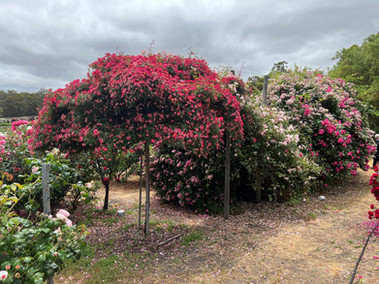


















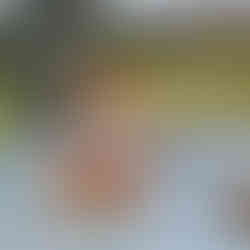











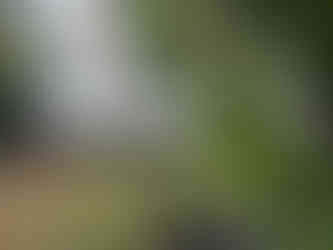

















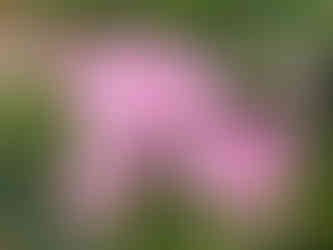




















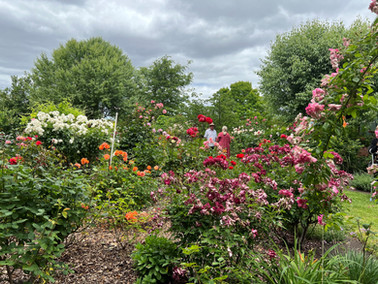







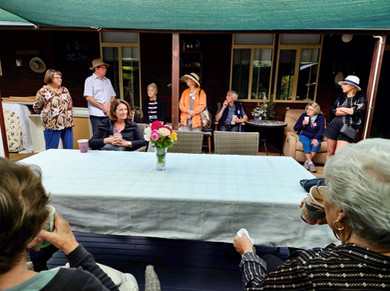









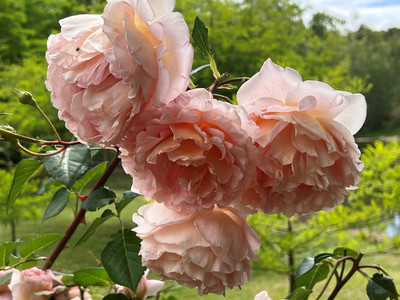
Comments